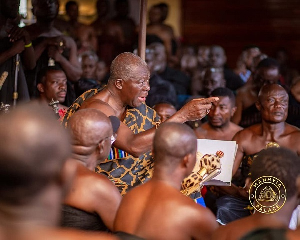Energy is one of the parameters in the value addition chain. The rest being TIME, TOOL, MATERIAL, MONEY, MAN POWER (HUMAN RESOURCE), INFORMATION; without energy there can be no production of any sort.
The present Energy crises are hitting hard on industry. Some foreign companies are already relocating outside Ghana. Ghanaian industrialists are losing out because of higher production cost as a result of the situation.
EXAMPLES OF EFFECT ON INDUSTRY:
1. In a normal biscuit factory continuous ovens are used for the production of biscuits. When power outage occurs the conveyer in the oven stops and it result in the damage of biscuits.
2. Industries using steam boilers are compelled to restart the boilers after the power has been re stalled. In other words, all the energy used in previously starting the boiler goes waste. Factories using extruders have special problems in that the extruder locks up during power outage because the operator could not clean the extruder before the power outage.
3. In a vegetable oil refinery vacuum pumps are used to stabilize the relation between temperature and pressure. If power goes off and the vacuum pump stops, the oil temperature rises uncontrollably completely destroying the oil.
4. Poultry farmers using incubators always lose out during power outages. These are some of the serious problems manufactures are experiencing as a result of the present power outage situation.
5. When you are in a steel mill, power outages can be catastrophic.
6. Finally, manufactures have to pay workers whether there is power or no power and this has resulted in a loss of revenue and increased wage bills.
MAIN OBJECTIVES OF ENERGY POLICY
CPP Policy would be aimed at providing uninterrupted and reliable but quality energy at a reasonably low cost to meet the domestic needs of the population and also the needs of industry, The policy will also meet the Transportation requirements, (Air, Water and Land Transportation).
The policy would also discriminate the use of energy for irrigation as against any other application .The policy will also look at conservation of energy to save cost. In this regard , attention would be paid to the use of energy saving bulb including LED.(light emission diodes), introduction of wind towers as is common practice in Australia and middle east, to suck out heat from buildings, the use of insulated materials in the walls of buildings as it is common in Denmark, to reduce heat transfer into the building, the use of solar water heaters to reduce energy demand for heating water for domestic applications i.e., cooking food, washing, bathing, etc.
Estate developers would be encouraged to set up waste disposal systems capable of generating biogas for use as well as installation of wind turbines for localized generation of power.
TRANSPORTATION
It is common knowledge that transport consume a lot of energy, in this regard, mass transport –buses, trains, promotion of water transport would be encouraged, special efforts would be made to improve transportation on the Volta lake and other rivers such as the Pra and other perennial rivers. The use of Gas and biodiesel would be strongly promoted as main fuel for transport vehicles.
SOURCES OF ENERGY: Since solar is the main source of energy for the earth, priority would be given to Solar. The next energy sources would be wind, hydropower, biomass, vegetable oil, biogas, natural gas, crude oil. There would only be limited use of crude oil.
Ethanol: The main emphasis would be on renewable fuels. Non- renewable fuels would be reserved for processing into various materials.
ENERGY HARDWARE:
A major policy of the CPP is to create capacity to build hydro power plants, wind turbines, gasification plants to convert biomass into gas, biodiesel plants and then biogas plants. We think it is unacceptable, that after fifty-six years, Ghana is compelled to import this kind of hardware without any kind of programme to build them. We have no reason to import transformers, insulators, hangers, switch gear, electric motors, and generators indefinitely into this country. This would be part of long-term programme with a timeline.
SOLAR:
The sun can be described as the principal source of energy for the universe. It is estimated than 5.7 hours of sunlight is enough to meet a year’s energy needs of the world. It is further estimated that solar energy dissipated on 1sq Km of the Sahara Desert is equivalent to 1.5 million barrels of crude oil. Ghana’s unique position on the globe only 4 degrees above the Equator and the meridian passing through Tema gives us exceptional advantage to tap energy from the sun.
We can harness the sun’s energy in three direct ways:
1. Water heating through coils over black metal sheet utilizing two tanks a) A supply tank b) Insulated reservoir tank. Temperatures up to 70 degree C can be achieved if the design is right. Hot water in this form can be used for miscellaneous application. 2. Use of photo voltaic (PV) appliances for generation of electricity for various applications. 3. Enhancing the sun’s energy through the use of mirrors for heating water, generating steam and producing power from steam turbines.
WIND POWER:
The CPP believes that Ghana needs to adopt the comprehensive approach to solving the energy problem. Contrary to general perception that Ghana has no wind potential, it is realized that only Ghana and Senegal on the West Coast have good capacity to produce salt. This is because both countries have a relatively higher wind speed that facilitates evaporation of sea water for salt production.
Findings from the U.S. Department of Energy, the National Renewable Energy Laboratory N.R.E.L, indicate that even at the height of 12 meters, wind speeds reach between 4m/s (meters per second) and 6m/s at Aploku and Mankoadze. Aploku is not far from Pambros Salt Ponds (Menskurom).
The 12m by 18 blades with 5m diameter windmills being manufactured by the Agricultural Engineering Services of the Ministry of Agriculture and FATECO LTD., producing torque at 1.8m/s wind speed means that such machines can be deployed nationwide for irrigation to reduce energy requirement.
Wind turbines if appropriately deployed in already available wind corridors enhanced under our tree planting programmes can be used to enhance our power needs.
We believe in the deliberate creation of wind corridors for power generation. Anybody can test widespread availability of wind by holding a large cardboard in an open field. With the aid of GPS and the wind map, potential wind corridors can be identified and harnessed for power generation. Wind speed tests conducted at Papaye Fast Food on the Spintex Road gave wind speeds between 7-9 meters per second. At Kawokudi Junction and Mamprobi Beach all in Accra, wind speeds of over 7 meters per second were very consistent. It is now known that wind power is viable whenever oil prices exceed $60.00 per barrel. With the oil price now over $100/barrel, there is no doubt that Ghana should closely pay attention to the potential of wind power.
Our investigations indicate that we can generate 10,000 megawatts of power from the Volta basin. The Volta River stretches over 1,000 kms; installing 3megawatts wind turbines (height 120 meters, blade diameter 85 meters) over this stretch can produce this power. Because the Volta basin is a wind corridor, there is no time that there can be no wind along this long stretch. If the wind turbines are installed triangular at the distance of 300 meters, it should be possible to generate 27,000 megawatts from these towers. At 33% efficiency, 9,000 megawatts can be guaranteed.
BIOFUELS:
We refer to any energy source that emanates from biological resource, i.e. plants and animals as biofuel. Since man has capacity to regenerate plants and multiply animals, these energy sources can be described as renewable. We must however understand that the sun is the original supplier of this energy. Plants and animals are energy convertors and suppliers of energy.
As a tropical country, Ghana has immense potential and overwhelming advantage to harness biofuels for energy and power generation. Vegetable Oil, ethanol, biomass and biogas belong to the biofuel group.
Vegetable oil is described as liquid solar energy. It is a hydrocarbon with very similar characteristics as crude oil.
After studying the Palm Oil Industry, the Germans concluded that actual production costs for Palm Oil are in the 150 to 250 Euro/ton range. It is further realized that West African extraction rates and yields are very low. At the same time production is done without fertilizers and pesticides, so that the palm oil is not grown sustainably!
The CPP asserts that no oil bearing seed in the temperate climate has more than 1000kg of oil per hectare. Yet in the tropics such as ours, we have oil bearing trees yielding over 3000kg of oil per hectare.
It is clear that the use of vegetable oil for power production is sustainable in Ghana if we use good methods.
In fact, our calculations indicate that if we can mobilize our people to plant about 7 million hectares of Almond trees – an oil bearing plant, Ghana can produce 20 million tons of vegetable within 6years. On the basis of German experience 12 million tons should produce 8000 mw of power; 90 million kw/hrs from the biomass through a gasification process.
Such a programme will create jobs for at least 14 million young people i.e. 2 persons per hector and thousands of others in the value addition i.e. high protein cake, edible plastics etc. 7 million hectors of forest in the Volta Basin would enhance rainfall, rejuvenate the Volta River to restore its potential to produce 4,300 mw of power. The country will also benefit from carbon trading.
Carbon dioxide absorption is estimated at about 100 tons/ha.
Ghana has untapped resources in vegetable oil. Presently we have about 30,000 acres of Para Rubber Plantation yielding about 30,000 tons of Para Rubber Seed with 42% oil giving us about 12,000 tons of vegetable oil. The Aboso Glass Factory was grounded due to inadequate power. The total demand there does not exceed 1 mw.
From extrapolations above 12,000 tons of Para Rubber Oil should give us about 8 mw. In fact, under President Nkrumah’s programme, the target was 75000 acres of plantation within 15 years i.e. ending before 1980 which would have given us 20 mw of electric power.
BIODIESEL PRODUCTION:
For the production of biodiesel for general transportation needs, we only require caustic soda, or potash, and ethanol or methanol. The process for converting vegetable oil to Biodiesel is quite simple. In other words with 20 million tons of oil and our diesel requirement not exceeding one million tons, we can have a sustainable programme to use vegetable oil to meet our transportation needs. Jatropha is the best feed stock.
For power generation we need not convert the vegetable oil into biodiesel. In any case, we can easily produce methanol from the natural gas coming as by-product from the crude oil presently discovered.
ETHANOL:
Ghana has enormous resources for the production of Ethanol. All what we need to do is to create conditions for harvesting the raw material – cocoa sweating during the drying fermentation process.
With cocoa production hitting one million tons of dry beans, equivalent by-product from the sweating should be very high. Cocoa Marketing Board should assist the Cocoa Research Institute to design drying platforms that allow harvesting of this commodity. Research Institution including the KNUST (KWAME NKRUMAH UNIVERSITY OF SCEINCE AND TECHNOLOGY) should determine the percentage of ethanol from a ton of dry beans. Institute of Industrial Research should link up to this programme by providing table top distillation plants and training programs for its successful implementation. The programme should be extended to link up with Distillery COMPANIES like formerly GHANA INDUSTRIAL HOLDING CO(GIHOC) to buy the alcohol from farmers or intermediate distillers for the production of Ethanol. The Bodwoase Starch Plant can surely become more viable if it went into a value addition chain including ethanol production. Roots and Tubers of the Ministry of Agriculture should be linked to this programme and support cassava farmers with small scale portable starch plants which can be made here for ethanol production.
Sweet Sorghum as a feed stock for ethanol should be encouraged since the stem of the Sorghum is a feed stock, this material does not threaten the food industry, so is the cocoa industry with respect to ethanol.
Ethanol has been used as automobile fuel for many years in various Regions of the world. Brazil is probably the leading user nation. In the 1990s about 5 million vehicles operated on fuels i.e. 93% ethanol. Presently new engines are available that run on flexible fuels, i.e. any mixture of ethanol and petrol. The country has a lot of miscellaneous plants with both biodiesel and ethanol potential. A value addition chain for our Agricultural raw material base should allow us to identify them.
ENERGY FROM OTHER WASTES:
Biogas can be produced from biodegradable landfills. For economic production of gas from landfills, a minimum of one million tons of land fill must be buried 40 feet deep. This information must guide us in designing our landfills to make sure that we have the possibility of extracting gas from all our landfills nationwide. Landfills designed as a hill can also be used for power generation if we mount a wind turbine on top of this artificial hill.
Biomass with densities above 200kg/cubic meter can be gasified for energy. This includes wood chippings, high density fibre (Almond), sawdust, etc.
Palm Kernel Shells have very high energy content. In fact, two tons of Palm Kernel Shell is equivalent to 1 ton of diesel in energy contents.
Animal waste including poultry droppings, fish oil, etc. can all be used for power production. The latest technology for extracting oils from oil bearing seeds and animals is termed supercritical. It is very efficient and operates at about 70 atmospheres at 300?C.
For the production of one pound turkey meat 1½pounds of waste, 12000 tons of pig slurry plus 30,000 tons of food waste produces biogas for 800 homes in Europe.
In Minnesota, 55 megawatts of power are produced from poultry liter.
NUCLEAR AND ATOMIC ERNERGY :
We have complete faith in atomic energy, we believe it is the safest and cheapest among all sources of energy but the initial cost of establishment is high and thus we will exhaust the potentials all the energy sources above before atomic or nuclear energy usage. The option must however be explored for the longer term. At this point, we refer to Dr. Nkrumah’s speech when inaugurating the Atomic Energy Project. At the ceremony marking the laying of foundation stone for the Atomic Complex on 25th November, 1964, Dr. Nkrumah said:
“Our sole motive in reaching the decision to build the Centre which you now see rising before you, is to enable Ghana to take advantage of the decisive methods of research and development which mark our modern world. It is essential to do this if we are to impart to our development that acceleration which is required to break even with more advanced economies. We have therefore been compelled to enter the field of atomic energy, because this already promises to yield the greatest economic source of power since the beginning of man.”
CRUDE OIL:
The U.S. is the biggest consumer of crude oil at 24 barrels per capita, followed by Europe at 12 barrels per capita. China presently consumes 2 barrels per capita followed by India with 1 barrel per capita. The Chinese in effect want to live like the U.S. This will naturally result in higher consumption of energy. Presently the Chinese are abandoning the use of bicycles. In 2007 VW alone sold 1 million cars in China. If the Chinese increase their crude oil consumption to 4 barrels, the country will need 5.6 billion barrels, i.e. 1.4 billion x 4. The world had 800 million cars in 2007 and car population is increasing worldwide. It is obvious from above that the price of crude oil is not likely to come down drastically.
Ghana should therefore take maximum advantage of the newly discovered oil reserves to ensure that the product benefits the entire population; downstream value addition should be our first option. This will avoid the so called curse of crude oil. Many products can be derived from crude oil. The lists below are some of the major derivatives:
1. Rubber tires, Inks and Paints 2. Varnish and painters chemicals 3. Turpentine 4. Lubricating oil 5. Soaps 6. Gasoline 7. Diesel Fuels 8. Insecticides and Sprays 9. Cutting Paper, Leather and Textiles Oils 10. Rubber Compounds 11. Solvent Creams and Ointments and Petroleum Jelly 12. Anti Rust 13. Fuel and Metallurgical Coke 14. Fertilizers The accompanying natural gas has 4 components: ? Methane ? Ethane ? Propane ? Butane All these have various uses. It is important to note that matters relating to crude oil cannot be resolved in isolation, i.e. outside National Development Agenda. For instance without the presence of an advanced Machine Tools Centre, giving capacity for machine building in Ghana, most of the ancillary services will have to be taken outside and Ghana would lose a lot of money.
HYDROPOWER GENERATION:
The CPP was aware even in the sixties that Energy was a major prerequisite in a value addition chain. We therefore took steps to enhance our energy supply base by embarking on the construction of the Bui Dam, to follow Akosombo At the time of the 1966 Coup all the design drawings for the Bui Dam had been completed and large quantities of constructional equipment and building materials including steel beams, angles, plates, large pumps, diesel electric generators and miscellaneous tubing were all at site. All these materials gradually disappeared from the site without anybody accounting for them. Dr. S.B. Arthur, a Soviet trained Ghanaian Hydropower engineer, had surveyed the hydropower potential of 10,001 rivers in the country and had quantified their energy potential. He estimated that the Volta Basin had potential to produce 4300 megawatts from 7 possible sites using the cascade method. Unfortunately it is not possible now to achieve this because we failed to protect the Basin. As a result of massive deforestation, the land can no longer retain its top soil which is continuously being washed into the river and thus causing siltation resulting in the spread of the lake and consequent higher evaporation.
As at 2010, Accra alone was receiving 60 truckloads of charcoal equivalent to at least 240 truckloads of fire wood every 24 hrs. The main source is in the North and Afram plains – the catchment rain source of the Volta River. Our estimate is based on 25% extraction rate. We can say without fear of contradiction that because of the inefficient method of charcoal production, there are cases where the extraction rate is only about 15%. The question that troubles us is that we had the Akosombo Hydropower which is four times bigger in capacity than the 400 megawatts Bui plant.
Furthermore, the Bui Lake is much smaller. The Akosombo Hydropower was built nearly 50years earlier (two generations). Why is it that we as Ghanaians are compelled to bring in a third party to build the Bui Dam? We asked if the Indians or the Koreans had been in this position would they have called on a third party to do this? Our KNUST was in existence over 50 yrs ago (2011). The South Koreans had the equivalent of our Engineering Universities i.e. KIST – “The Korean Institute of Science and Technology,” 15 yrs after the establishment of KNUST. The Koreans do not invite third parties to build their hydropower plants, so why? Why? We don’t believe that if Kwame Nkrumah had lived till now, this situation could have happened.
Yes our political leaders must be compelled to explain this.
ACTION REQUIRED:
Our political leaders must not allow this situation to repeat. We need to take steps to empower our people now to have full capacity to build Hydropower Plants. We must have a programme with quantifiable targets to achieve this. Whatever needs to be done must be done now for we still have a number of small rivers and stream with hydropower potential. The Pra River has potential to produce 120 megawatts of power.
6yearrs ago (2005), Ghana received two 30 kw hydropower plants from UNIDO for study and replication. The Prof. Damodaran who happened to be the deputy head of small and mini hydro plant – a UNIDO project in China. the plants are still in boxes at V.R.A. depot in Tema. Would this have happened the CPP was in power? Certainly not!
It is important to explain that only a comprehensive approach to solving Ghana’s problems will be viable. For instance, Tree Planting which is a forestation activity is the responsibility of the Forestry Department and theoretically has nothing to do with energy. Yet we realize that only this department can arrest the deforestation presently going on.
We have struck oil, yes, but the only way to prevent an oil curse is to go for the value addition chain in order to spread the wealth base.
We must use the biofuel for power and energy and multiply our revenue through a value addition chain of crude oil.
We must go in for meticulous planning with quantifiable targets, ingenuity, and endeavor, backed by uncompromising determination. FAILURE IS NOT AN OPTION!
Robert Woode - Crusading Engineer CPP Spokesperson on Energy www.conventionpeoplesparty.org
Press Releases of Monday, 4 March 2013
Source: CPP













